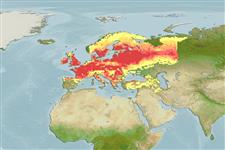Classification / Names
Common names from other countries
Main reference
Size / Weight / Age
Max length : 61.7 cm TL (female); common length : 20.0 cm TL male/unsexed; (Ref. 556); max. published weight: 0.00 g; max. reported age: 19 years (Ref. 27368)
Length at first maturity
Lm 8.1 range ? - ? cm
Environment
Freshwater; brackish; benthopelagic; pH range: 7.0 - 7.5; dH range: 10 - 15; potamodromous (Ref. 51243); depth range 0 - ? m
Climate / Range
Temperate; 2°C - 22°C (Ref. 27368), preferred ?; 62°N - 36°N, 10°W - 70°E
Distribution
Eurasia: Most European rivers north of Pyrenees and Alps, eastward to Ural and Eya drainages, Aral and White Sea basins; Black Sea basin in Europe and northern Asia Minor. Naturally absent from Iberian Peninsula, Adriatic basin, Italy, Greece south of Pinios drainage, Great Britain north of 54 N, Ireland and Scandinavia north of 62° N (Ref. 59043). Definitely absent in Siberia. Reports from this area arose from the confusion between the rudd and the roach (Ref. 1441). Introduced to several countries. Several countries report adverse ecological impact after introduction (Ref. 1739).
Countries | FAO areas | Ecosystems | Occurrences | Introductions
Short description
Dorsal
spines
(total): 3;
Dorsal
soft rays
(total): 8-9;
Anal
spines: 3;
Anal
soft rays: 8 - 12;
Vertebrae: 36 - 39. Distinguished from its congeners in Europe by the following combination of characters: 39-42 scales along lateral line; anal fin with 10-13½ branched rays; 9-12 gill rakers; dorsal head profile straight or slightly convex, snout pointing forward, tip at or slightly above level of middle of eye; back not humped behind nape; eye bit close to dorsal head profile when viewed laterally; articulation of lower jaw in front of anterior margin of eye; head and body compressed, head width 13-14% SL; head length 24-28% SL; caudal peduncle depth 1.5-2.0 times in its length, 11-12% SL; and all fins with reddish hue, pelvic fin deep red (Ref. 59043).
Caudal fin with 18-19 rays (Ref. 2196)
IUCN Red List Status (Ref. 115185)
Threat to humans
Potential pest (Ref. 52336)
Human uses
Fisheries: minor commercial; aquaculture: commercial; gamefish: yes; aquarium: commercial; bait: usually
Tools
Special reports
Download XML
Internet sources
Estimates of some properties based on models
Phylogenetic diversity index
PD50 = 0.5010 many relatives (e.g. carps) 0.5 - 2.0 few relatives (e.g. lungfishes)
Trophic Level
2.9 ±0.39 se; Based on food items.
Resilience
Low, minimum population doubling time 4.5 - 14 years (K=0.09-0.18; tm=3-4; tmax=19)
Vulnerability
High to very high vulnerability (69 of 100)
Price category
